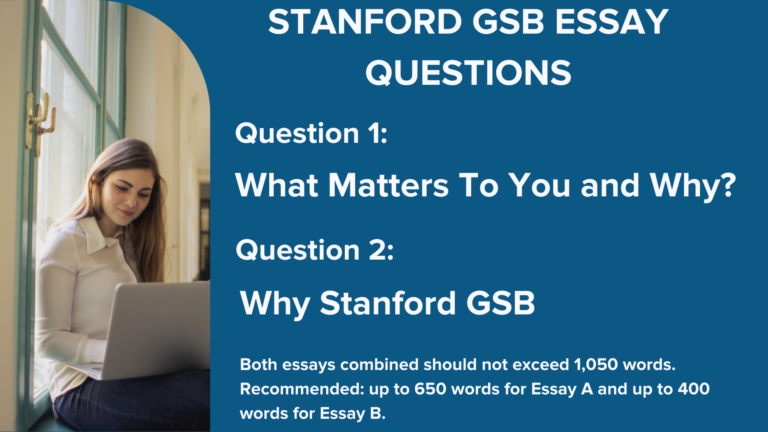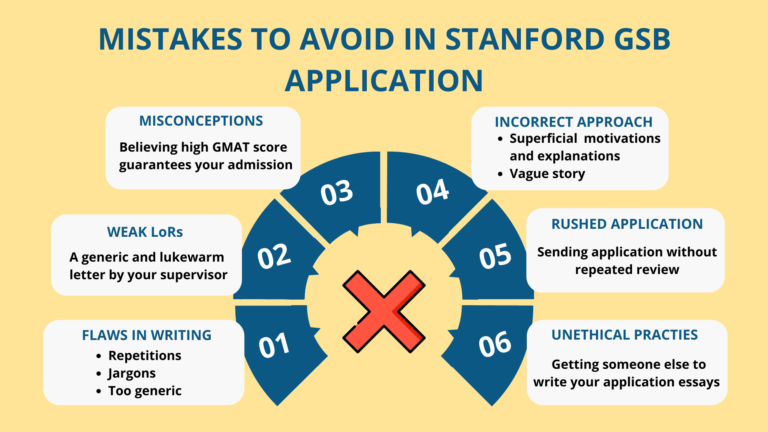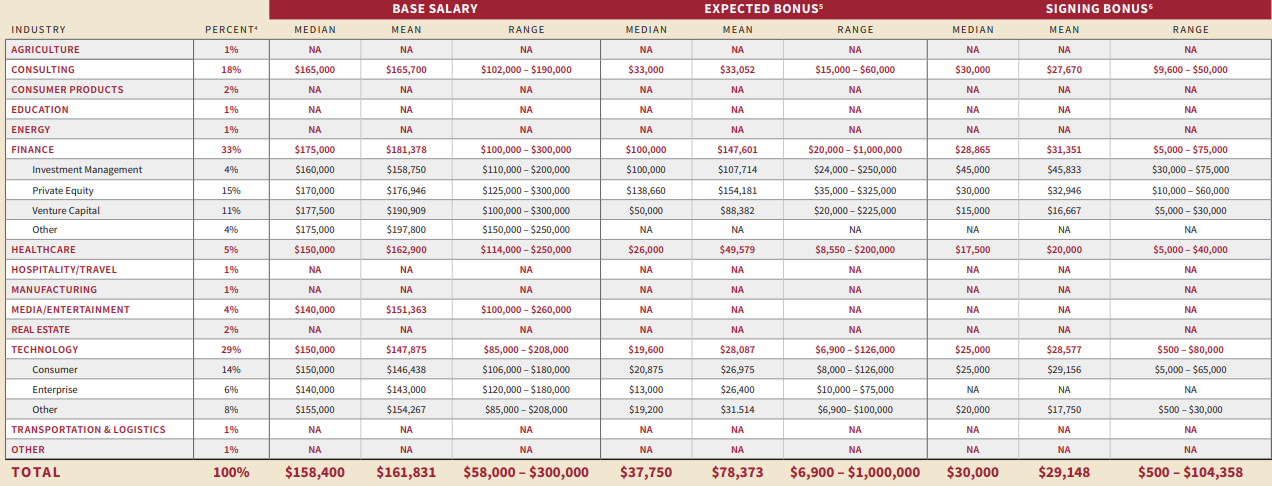Table of Contents
ToggleHere are the questions this article will answer:
- What Makes Stanford GSB One of The Best B-Schools?
- How Hard is it to Get Into Stanford MBA Program?
- 3 Key Ingredients for a Great Stanford GSB Applications
- How to Write Stanford Application Essays
- Stanford GSB Application Essay #1: What Matters To You And Why?
- Stanford GSB Application Essay #2: Why Stanford GSB?
- Key Mistakes to Avoid in Stanford Application
- Mistake #1: Flaws in Writing
- Mistake #2: Weak Letter of Recommendation
- Mistake #3: Misconceptions
- Mistake #5: Rushed Application
- Mistake #6: Unethical Practices
Everyone tries their best to get into Stanford GSB but few succeed due to intense competition. Worried about how to write Stanford MBA application essays? This article will help you maximize your chances of getting through Stanford GSB by sharing ways to enhance your application and the most common traps that applicants fall into.
What Makes Stanford GSB One of The Best B-Schools?
- Class size: Unlike the large batch of HBS of around 900, Stanford GSB’s short class size of about 400 students fosters better connections with batchmates. Every week, sessions called TALK has two students present their personal story with their batchmates for 30 minutes each. This helps to bring the community together and promote a highly collaborative environment among diverse cross-functional professionals.
- Teaching curriculum: Stanford’s faculty is one of the best in the world, including Nobel laureates. This is the primary reason why they select applicants who are keen on learning. The faculty ensures that their teaching methods and courses are out of the box – be it their unique Data Analytics course or Interpersonal Dynamics class, popularly known as ‘touchy feely’. Interestingly, the latter has been voted the most popular elective course in the past 45 years.
- Opportunities after graduation: According to John Byrne of Poets and Quants, Stanford sends more people into private equity and venture capital than any other college. It is equally reputed for its focus on entrepreneurship and social impact. The average salary of Stanford GSB graduates was USD 190,979. The college is known to produce more cabinet ministers, CEOs, and alumni in extremely powerful positions.
How Hard is it to Get Into Stanford MBA Program?
While Stanford GSB does not reveal its official acceptance rate, experts estimate it to be anywhere between 4-6%. This makes it one of the most selective MBA programs in the world. Of the 7,367 applicants for the class of 2023 to Stanford, merely 426 enrolled.
The average GMAT score accepted is 737 but even a higher score does not necessarily guarantee admission. Dean Emeritus Robert Joss had once remarked that he could “double the size of the incoming MBA class without even touching the quality,”. In other words, even the best candidates are rejected each year and you could be one of them too.
In addition to phenomenal GMAT scores, you need certain key elements in your application that make or break your case. Read on to find out what are those elements and how to best showcase them.
The First Step to Your MBA Journey is 740+ GMAT Score
3 Key Ingredients for a Great Stanford GSB Applications
Stanford believes in using past achievements, and examples to predict future behavior, accomplishments, and overall growth. Admission committee members repeat three key ingredients for a successful Stanford GSB application:
- A Pattern of Excellence
You must demonstrate a clear and consistent pattern of academic and professional excellence. Put the spotlight on the ‘spikes’ or achievements in your profile: high GMAT score, excellent GPA, promotions, extracurriculars, etc. Think creatively about what makes you stand out. Regardless of the differentiator you choose, underline what proves that you are among the top 3% of your peers.
2. Leadership Potential
Premium business schools emphasize on incoming students demonstrating exceptional leadership skills. This could be in any form – leading a giant team, rising to an unforeseen challenge, making crucial decisions in high stake situations, taking risks, etc. Leadership experience need not necessarily be in professional setup only, but also through your extracurricular activities. The focus should be on what can paint you as a leader of tomorrow. However, remember that Stanford does not just desire a great leader, but one who will be a good fit within their community!
3. Fitting in the Stanford Community
This brings us to the last ingredient. Stanford ad-com wants to learn how will you contribute to the Stanford community and make the best out of what it has to offer. They look for someone who will not only be a good fit in the Stanford circle but also with the rest of the candidates who have been chosen. Demonstrate how collaborative nature and how you will bring energy and engagement to school clubs, research centers, and other facilities exclusively for the students.
How to Write Stanford Application Essays

The open-ended nature of the Stanford application essays is not easy to tackle. The essays can only be answered after deep introspection and an understanding of oneself. Generic online samples are easy to spot by ad-com and can never match up to what you can write with just a little guidance. Here are some key pointers that will help you channel your thoughts in the right direction:
Essay 1: What Matters To You And Why?
The rationale behind this question is to gauge who you are as a person, as opposed to your professional accomplishments which are highlighted in your resume. This essay’s purpose is to learn who you are as opposed to what you have done.
The ad-com wants to understand the people, insights, and experiences that have shaped you into who you are today. Which values, dreams, and motivations shape your identity? What is most meaningful to you? What is it that keeps you up at night? What ambitions do you harbor and why are they so important to you?
Remember that this essay will be impressive only if it is heartfelt, personal, authentic, and truly your voice. Touch upon the key highlights of your journey that shaped you into the person you are today. The essay should be used to show what makes you unique and what you bring to the table.
Essay 2: Why Stanford GSB?
Where do you see yourself in a few years and how is Stanford a key milestone in the journey? The most common mistake applicants make while attempting this essay is writing generic or cliche answers. Trust me -the admissions committee has seen it all.
Research about the school in depth to understand what makes Stanford, its curriculum, and other offerings unique. As mentioned before, be honest and authentic. In the previous essay, you highlighted your aspirations; now use this essay to show how can Stanford GSB program help you achieve them.
Try to show what is needed to fulfill your career vision that only the Stanford program can offer to harp upon why your selection matters. However, make sure that the professional goals you mention relate to your experiences and that you have demonstrated the ability to accomplish them.
Irrespective of the essay, remember – Stanford values candidates who are passionate about creating an impact and want to impact their surroundings. Demonstrate what you want to change and why. Refrain from writing unrealistic assertions such as wanting to change the world, but discuss what honestly resonates with you: be it changing your company, industry practice, or your community. While leadership skills are important, leadership and your other attributes should be geared towards something.
Key Mistakes to Avoid in Stanford Application
Here are some of the most common mistakes in Stanford GSB application that immediately ruin applicants’ chances of getting through:

Mistake #1: Flaws in Writing
a. Repetition: Stanford GSB application has detailed pre-essay information. Do not repeat the information provided in those or resume points in the essays. Offer new information because the committee sees the entire application together and they want to see how you utilized all the questions to present all sides of your personality.
b. Jargons: Please avoid using any industry-related jargon. The admission committee believes that your application should be understandable for anyone who reads it, irrespective of their professional background.
c. Too generic: Offering vague and cliched answers instantly drops the reader’s interest in you and reduces your chances of selection. It shows a lack of effort and sincerity by the candidate.
Mistake #2: Weak Letter of Recommendation
A generic, lukewarm Letter of Recommendation that does not seem to push for you drastically lowers your chances. If people you have worked under have nothing extraordinary to highlight about you, do not expect committee members with the highest of standards to be keen on you. Only get LoRs from those who will root for you in their account of your work.
Please note: If you are a student or self-employed or haven’t notified your supervisor that you are applying to Stanford MBA, then you can find the next best alternative for a good letter of reference. But it should be from someone who has supervised your work.
Mistake #3: Misconceptions
a. A GMAT score guarantees admission: While Stanford values a high GMAT score, they have also accepted applications from those who scored 690-700 because of their impressive profiles. A 99th percentile does not guarantee admission; the entire application must present you as a promising candidate with multiple impressive facets.
b. Learning does not matter – Showing that you are not inclined towards learning from professors who are deeply proud of their work is a big no-no. Remember, you are not there just to socialize but to also learn. The ad-com wants to see that this aspect is important to you. Stanford GSB has a demanding curriculum and it is imperative that you demonstrate your desire to learn and grow.
Mistake #4: Incorrect Approach
a. Superficial reasons: Do not say you want to get into the Stanford GSB program just for the brand name or because you see yourself in Silicon Valley or as an entrepreneur. There needs to be deeper reasons for you professional goals. Write about your career vision and why do you want to realize it. Superficial reasons for wanting to get selected show immaturity and short-sightedness – definitely not what you’d want them to think
b. A vague or no story: Did you proceed through life aimlessly without carving your niche? Were your decisions active choices or accidents? Your life has to be woven into a story where YOU are the protagonist. Discuss what was the common thread that weaves your decisions and actions together.
c. Stating the obvious: If anyone can surmise what you would have learned, skip writing that. For example, learning leadership skills from leading a team. Delve deeper and write unique aspects about your journey instead of obvious points that seem like fillers. Make every word count.
Mistake #5: Rushed Application
There are multiple opinions regarding which round is the best time to apply. Often to finish the application on time, several applicants write their essays in a hurry. However, the best time to send your application is when you know that it is the best you can make it. Seasoned professionals in the ad-com can quickly gauge when essays are written in a rushed manner. Take your time to write, edit, and get objective opinions on it. There is no sin bigger than a spelling or grammar mistake in your essays; so spend time reviewing it.
Mistake #6: Unethical Practices
While it is always a good practice to seek feedback on your essays, do not ruin your chances by having someone else write your entire essay. There is a stark difference between a person’s writing style and voice and that of a trained consultant. The website clearly states that allowing others “to craft any part of your application” is a violation of their terms and conditions and will result in the rejection of your application.”
Conclusion
Remember to view the application as a puzzle where each question’s answer is a piece – when all answers should come together to reveal a clear, complete, and connected picture. Remove all repetitions and contradictory statements. No hack from the internet will help you as much as writing your true story in your voice. Follow the tips given above and you are bound to have a strong application to send to Stanford GSB.
Hoping to win over the ad-com through your extracurriculars? Learn how in Importance of Extracurriculars For Your MBA Applications





